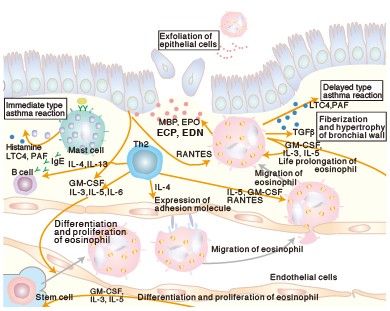Immunology
The living body is exposed to various pathogens, yet its health is maintained through defense mechanisms that sense and eliminate pathogens such as the immune system or through coexistence mechanisms in the case of some pathogens. Pathogens act as a danger signal to the host. Pattern recognition receptors (PRRs) expressed in some immune cells immediately recognize the danger signal and trigger activation of the immune system1.
PRRs are generally divided into two types according to the mode of existence. One type is toll-like receptors (TLRs) that perceive the structures common to microbes outside the cell (Figure 1, Sensor 1)2. Examples of TLR ligands are peptidoglycan and lipopolysaccharide (LPS) derived from bacterial cell walls. TLR4, an LPS sensor, recognizes LPS on the surface of cells in cooperation with CD14 and MD2 to transmit signals into the cells. TLR7 and TLR9 are located in intracellular endosomes. TLR7 recognizes viral single-stranded RNA (ssRNA) while TLR9 recognizes bacterial, viral CpG DNA.

The NLR family recognizes not only microbial components, but also danger -associated molecular patterns (DAMPs) such as double-stranded DNA, ATP and uric acid inflammation-causing environmental factors including asbestos, silica, and aluminum hydroxide for adjuvant use. The activated NLR recruits procaspase-1 via the adaptor protein ASC (apoptotic-associated speck-like protein containing a caspase recruitment domain) into a supramolecular complex called inflammasome. Procaspase-1, approaching each other during the formation of the inflammasome and undergoing autodigestion, becomes activated caspase-1. Its enzymatic activity cleaves the precursors of IL-1 family cytokines, IL-1β and IL-18, for maturation.
As mentioned above, inflammasomes play a critical role in the defense system against pathogens. Therefore, breakdown of this system will lead directly to the onset of disease. Mutations in NLRP3/cryopyrin (a member of the NLR family) cause excessive production of mature IL-1 in association with constitutive activation of inflammasomes and may result in the development of cryopyrin-associated periodic syndrome (CAPS), an autoinflammatory disease. Mutations in the pyrin domain of ASC or the NOD2 gene are detected in patients with familial Mediterranean fever or inflammatory colitis-associated Crohn’s disease. Many IL-1 family members function as inflammatory cytokines and their immunoreaction-inducing ability varies widely. As a matter of fact, the immunosuppressive activity of IL-37 has been reported. No reports are available on the physiological functions of other IL-1 family members. Future analysis will reveal their functions and significance. Further, inflammasomes modulate immunoreactions by (indirectly) recognizing substances (such as inorganic substance and metal salts) via unknown receptors. It is thus expected that use of this characteristic feature will enable the application not only to treatment of cancer and autoimmune diseases, but also to improvement of vaccine efficiency, via artificial compounds controlling inflammasomes activity.
Bronchial asthma and eosinophil
Eosinophil Cationic Protein (ECP), Eosinophil Derived Neurotoxin (EDN) and Major Basic Protein (MBP) are known to be major protein-mediators derived from activated eosinophils. Activated eosinophils play an important role in inflammatory processes, especially in allergic diseases. The level of eosinophil activation can serve as complimentary data for monitoring asthma inflammation.
As ECP/EDN proteins are secreted from activated eosinophils, they become markers of eosinophil activation and degranulation which can cause inflammatory disease of the airway.

- Matzinger P, The danger model: a renewed sense of self. Science, 296, 301-5 (2002) PMID: 11951032
- Kawai T, Akira S, Toll-like receptors and their crosstalk with other innate receptors in infection and immunity. Immunity, 34, 637-50 (2011) PMID: 21616434
- Martinon F, Mayor A, and Tschopp J, The inflammasomes: guardians of the body. Annu. Rev. Immunol., 27, 229-65 (2009) PMID: 19302040

